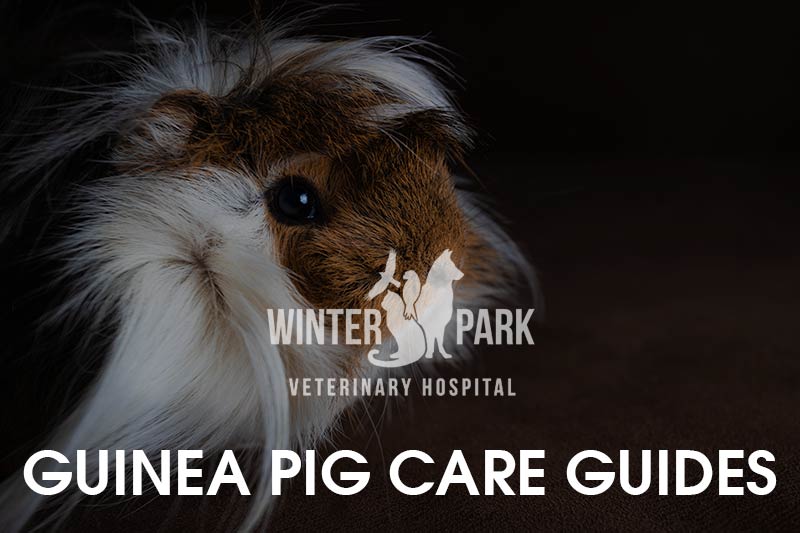Download Guinea Pig Care Guide – PDF
Additional information provided by Dr. Romiro Isaza & Dr. Marjorie Bercier, University of Florida
The guinea pig or cavy, Cavia porcellus ,is a rodent related to chinchillas and porcupines that originated in the Andes Mountain region of South America. Guinea pigs are social herbivores that do better when housed with one or more other guinea pigs. Their life span is typically from 5-8 years with proper care.
Handling and Restraint
Guinea pigs rarely struggle violently when picked up or restrained, but will frequently squeal loudly. They almost never bite or scratch intentionally. Great care is needed when lifting a guinea pig so as not to cause injury. The guinea pig is best lifted with two hands: one under the chest and abdomen, the other supporting the hindquarters. Provide gentle and total support for adults and, especially, pregnant females.
Enrichment
Aside from daily handling, guinea pigs benefit from running wheels, escape tunnels (wide PVC pipes), ladders, or plywood boxes (to climb on). Indoor playpens are also a great way of offering your pet a place to roam outside of his/her cage.
Housing
Proper housing is a major factor in maintenance of healthy guinea pigs. Guinea pigs can be housed in enclosures made of wire, durable plastic, stainless steel or glass. Regardless of enclosure type, providing good cross-ventilation is very important. Wire is the poorest choice of the four. Wood is not appropriate, as it does not stand up to gnawing. The design of the enclosure needs to prevent escape and be free of sharp edges. If the sides of the enclosure are at least 18 inches high, 24 inches wide, and three to six feet long; no top is needed. An exception to this would be if the home also has other animals, such as dogs, cats, or ferrets that may act as predators. Guinea pigs require a minimum of two square feet of open space per adult.
Solid flooring and an adequate supply of bedding material is best for guinea pigs. Never use wire-floored enclosures as they can cause serious foot and leg injuries. Use an enclosure that is easy to clean, well ventilated and adequately lit. The ideal conditions are 65° F to 75° F with 45% to 50% humidity. (This is slightly cooler than most homes.) At least two inches of bedding in the cage is recommended. The proper bedding is clean, dust-free, non-toxic and absorbent. Shredded paper or products such as Carefreshä are the preferred bedding materials. Do NOT use cedar or pine shavings — the resins can cause irritation of the skin, respiratory tract and mucous membranes. Avoid sawdust from any wood — it can collect in the ears and external genitalia of males, causing an impaction. Aspen shavings are acceptable though it can occasionally also cause problems due to ingestion and trauma to the eyes.
Place the enclosure in a quieter area of your home. Guinea pigs startle easily and can panic, running around the enclosure, squealing, overturning food and water dishes and flinging bedding in all directions. Youngsters can be trampled and seriously injured during such outbreaks. Some frightened guinea pigs will freeze in place for several minutes. Visual security (a hiding box) is a good idea. The guinea pig(s) can enter this cover when threatened or startled. Other pets in the home (especially cats and dogs) cause stress in guinea pigs. If you have guinea pigs and other pets, a hide box is a must.
Hygiene
As a general rule, the entire enclosure will need to be scrubbed thoroughly once weekly (twice weekly if the minimum floor space requirements are used). Food and water containers are best cleaned daily. More than one set of food and water containers is a good idea; when one set is soiled, the clean set can be used and the dirty set cleaned. Vinegar will dissolve the urine scale on the enclosure’s bottom. Use plenty of soap and water to scrub the enclosure and rinse completely. A mixture of 2 ounces of chlorine bleach to a gallon of water can be used weekly as a disinfectant after the enclosure has been scrubbed. Be sure the enclosure and feed dishes are thoroughly rinsed and dry before use.
Feeding
Guinea pigs are strict herbivores. Good-quality food and fresh water is necessary at all times. Provide both high-quality timothy hay-based guinea pig pellets (such as Oxbow Cavy Cuisineä). Most guinea pigs will not overeat (usually eat about 1/8 cup per day) but the amount of pellets may need to be restricted if a guinea pig becomes obese. Commercial pellets should have 20% crude protein and 16% fiber, which can be identified on the side of the bag or box.
Guinea pigs should have access to high-quality timothy hay or orchard grass at all times. Do NOT offer alfalfa hay to guinea pigs older than 6 months of age. Alfalfa hay has too high calcium content, which can cause fatal kidney and bladder stones in guinea pigs. Guinea pigs less than 6 months of age and pregnant and nursing sows can be offered alfalfa-based pellets and some alfalfa hay.
A variety of fresh vegetables (especially leafy greens) and some fruits should be offered daily. Leafy greens should make up the bulk of the vegetable supplementation, and fruits and other vegetables can be offered in small quantities. Remember iceberg lettuce has very little nutritional value. Good choices include: spinach, turnip greens, parsley, romaine lettuce, carrots, green and red bell peppers, apple, apricots, bananas, blueberries, cantaloupe, grapes, oranges, strawberries, and tomatoes can also be fed. For more information, see our Guinea Pig Shopping List sheet.
Supplementation of Vitamin-C is also required in guinea pigs as they are unable to manufacture their own. Without enough vitamin C, guinea pigs can become severely ill. The amount of vitamin C required varies around 10-30 mg/day. The vitamin C provided in guinea pig pellets will degrade quickly and generally is not sufficient. Supplement vitamin C by offering a daily tablet such as Oxbow’s GTN-50Cä. We do not recommend adding vitamin supplements to the water, as this can encourage bacterial growth in the water bottle.
Use sipper bottles to provide water. Rinse the bottles in hot water daily. More than one bottle to each enclosure is a good idea. Place the bottle(s) so the sipper tip is above the bedding. If the tip comes in contact with the bedding, the entire contents of the bottle can leak into the bedding. Replace the bottle when the tip becomes chewed and begins to drip.
Guinea pigs may refuse to eat if the location or nature of their food changes drastically. Make any dietary changes gradually and place their food supply in the same area(s) each day. Guinea pigs have sensitive intestinal tracts. A sudden alteration in diet (including food brand) may result in serious GI upset and anorexia. Food is best offered in ceramic crocks that resist tipping and will be tall enough to be out of the bedding. Placing food crocks on shelves slightly above the level of the bedding is a good idea.
Breeding
We do not recommend breeding your pet guinea pigs. Many guinea pigs are in need of good homes and are available through adoption agencies. Breeding your female guinea pig can cause life-threatening complications such as pregnancy toxemia and dystocia. Also, a female guinea pig must be bred before they reach seven months of age, because past that point the pelvic symphysis bones will fuse, and the female will not be able to give birth without a caesarian section.
Brushing, Bathing, & Nail/Teeth Trimming
Regular brushing will help keep your guinea pigs coat in good condition. Small brushes or metal combs can be purchased at any store. Brushing provides a good opportunity to check for problems such as lice or sores on the skin. The amount of time you spend brushing your pet will depend on hair length or shedding. Unless your guinea pig has become soiled or has a skin condition, bathing is often unnecessary and an added stress to your pet. All guinea pigs will require regular nail trimmings. It is best to bring your pet in to the veterinarian monthly for a pedicure. Guinea pigs also have “open rooted” teeth. This means they constantly grow. Routine visits to your veterinarian can help identify overgrowth and resolution through trimming.








